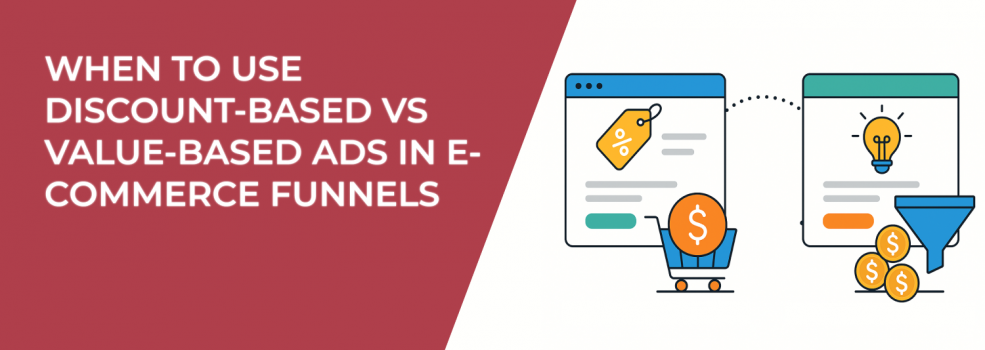Discounts can trigger fast sales, but brand value builds lasting loyalty. In this guide, we’ll break down when to use each strategy within your e-commerce funnel — so you can increase conversions without sacrificing long-term growth.
Why This Choice Matters
In digital marketing, every ad acts as a conversation with your audience — and how you start that conversation influences whether it leads to a conversion or gets ignored.
Discount-based ads send a clear message: “Here’s a deal.” Value-based ads take a different approach: “Here’s why we’re worth it.”
Both strategies can work, but the real question is: which one is more effective for your goals? Which one helps build stronger customer relationships? Which one fits the stage your audience is in within the marketing funnel?
This choice goes beyond simple tactics. It’s about timing, audience psychology, and understanding the customer journey from awareness to purchase. When used correctly, the right ad strategy can lead to higher returns, lower churn, and better long-term growth.
If your ads aren’t performing well at certain stages of the funnel, you may be facing a messaging mismatch. Learn how to structure your Facebook ads funnel effectively to ensure each message aligns with where your audience is — and what they need to hear.
What Are Discount-Based Ads?
Discount-based ads use price incentives to encourage immediate action. They lean on psychology — urgency, scarcity, loss aversion — to push users toward conversion.
They’re often short-term tactics, but highly effective when used right.
Examples include:
-
“25% off sitewide — this weekend only.”
-
“Free shipping on orders over $50.”
-
“Use code SAVE10 for your first purchase.”
Psychological triggers at play:
-
Urgency: Fear of missing out drives faster decisions.
-
Reward sensitivity: People feel rewarded for ‘saving.’
-
Anchoring: Original price makes the discount feel bigger.
But there's a trade-off: discounts can train your customers to wait for sales — or worse, reduce your product’s perceived value.
That’s why they should be used with purpose — not as a default setting. Choosing the wrong campaign goal or optimization event could make these ads underperform. Before launching, revisit this guide on Meta ad campaign objectives to make sure your setup supports your strategy.
Use Discount-Based Ads in These Situations
Let’s look at where discount-based ads can do the most good:
1. Bottom-of-Funnel (BOFU) Nudges
Prospects at the bottom of the funnel are on the fence. They’ve browsed. Maybe even added to cart. But something is holding them back — price, indecision, distractions.
This is the moment to offer a gentle nudge with a targeted discount.
Scenario: A shopper has added sneakers to their cart but hasn’t checked out after 48 hours. A well-timed ad offering “15% off your order — just for you” could break the hesitation.
Tips:
-
Use dynamic product ads for relevance.
-
Limit the offer window to 24–48 hours.
-
Personalize the messaging with urgency: “Your cart misses you.”
If you're unsure how to re-engage these users, see this detailed guide on how to set up Facebook retargeting specifically for e-commerce.
2. Retargeting After Engagement
Someone clicked on a product page, maybe even spent time exploring. But they bounced. Retargeting with value messaging may not cut it anymore — they already know your value.
This is where a discount becomes a decision trigger.
Example ad: “You looked at this… now get 20% off for the next 24 hours.”
Smart tactics:
-
Combine pixel tracking with purchase intent signals.
-
Keep the ad focused on that one product or category.
-
A/B test between 10%, 15%, and tiered offers.
Still not converting? You may be missing more than just the right offer. Read Facebook Ads Not Converting: How To Fix It for diagnostic steps to realign your creative, copy, or audience.
3. Inventory Clearance or End-of-Season Sales
You need to move stock. Fast. Maybe it’s winter gear in March or limited-edition items that didn’t perform as expected.
Here, value messaging won’t help. You’re not selling the story — you're selling space.
Best practices:
-
Use countdown timers and “last chance” copy.
-
Group items by urgency (e.g., “Only 3 left in stock!”).
-
Don’t overuse this tactic — it can devalue your brand over time.
See how to use Facebook ads for e-commerce promotions and discounts to make these offers effective without undermining your long-term brand equity.
4. Welcome Offers for First-Time Buyers
New customers need a reason to try you. A small discount — like 10% off or free shipping — can reduce friction and increase first-time conversions.
But it should feel exclusive. Not generic.
Example: “Welcome to [Brand Name] — your 10% off code is waiting inside.”
Pro tip: Pair the discount with a value-based email series that introduces your mission, social proof, and bestsellers. Don’t let your first interaction be all about price.
What Are Value-Based Ads?
Value-based ads tell your brand story. They spotlight product quality, solve customer pain points, and highlight unique benefits that justify your price.
These ads appeal to logic and emotion — not discounts.
They work best when your product isn’t the cheapest — but is worth more.
Common angles include:
-
Durability: “Our backpacks come with a lifetime guarantee.”
-
Social proof: “Over 100,000 customers trust us — and here’s why.”
-
Mission: “Every purchase supports clean water projects.”
-
Lifestyle: “Designed for the modern traveler.”
Why they work:
-
They attract value-driven buyers, not deal hunters.
-
They build brand loyalty that extends beyond a single purchase.
-
They strengthen positioning against competitors.
If you're not clear on who your message is really for, learn how to define your target audience step-by-step so your ads connect with intent.
When Value-Based Ads Work Best
1. Top-of-Funnel (TOFU) Awareness
First impressions matter. You don’t have trust yet — so leading with discounts can feel gimmicky.
Instead, lead with your why.
Scenario: You sell eco-friendly cleaning products. Your ad says, "No toxic chemicals. No plastic waste. Just plant-powered cleaning that works." This positions your brand as thoughtful, ethical, and effective — before price is ever mentioned.
Best practices:
-
Use storytelling visuals (behind the scenes, founder story, etc.).
-
Highlight customer reviews or expert endorsements.
-
Use carousel ads to showcase different lifestyle angles.
2. Consideration Stage
At this point, users are comparing options. They might be reading reviews, watching unboxings, or asking friends.
This is your chance to differentiate through value.
Ideas:
-
Highlight superior materials or unique features.
-
Create comparison charts with competitors.
-
Emphasize guarantees, support, or product trials.
Example ad: “Unlike other yoga mats, ours stays grippy even in hot sessions. That’s why over 12,000 instructors recommend it.”
3. Premium Product Positioning
Selling high-ticket items? Avoid discounts — they cheapen the perceived value.
Instead, show why the product is worth it.
Example: “Our watchmakers spend 1,000 hours crafting each timepiece — and it shows in every detail.”
Use video ads to demonstrate quality, design, or the craftsmanship that justifies the price.
4. Post-Purchase Loyalty
Don’t stop advertising once the sale is made. Show up afterward with value-based messaging that reinforces their decision.
Scenarios include:
-
Highlight how to use the product better.
-
Share community stories or testimonials.
-
Offer access to exclusive product drops.
-
Promote relevant product bundles or add-ons.
This is where cross-sell campaigns in e-commerce shine — they increase order value while reinforcing customer satisfaction and trust.
Mixing Both in the Funnel: A Smart Combo
The smartest e-commerce brands layer both approaches — value first, then discounts when necessary. But placement and timing are everything.
Here’s a simple structure:
TOFU — Value-Based Ads
-
Showcase your brand identity.
-
Create awareness through storytelling, quality, and mission.
MOFU — Value + Social Proof
-
Educate on features, benefits, and comparisons.
-
Use testimonials, influencers, and UGC.
BOFU — Discount Nudges
-
Retarget abandoned carts with limited-time offers.
-
Provide loyalty-based discounts or bundles.
Example funnel for a skincare brand:
-
TOFU: “Why our plant-based ingredients work better — backed by dermatologists.”
-
MOFU: “Over 10,000 5-star reviews. See what customers are saying.”
-
BOFU: “Still thinking it over? Here’s 10% off your first order — ends tonight.”
Looking to make seasonal offers pop without eroding your margins? Learn how to maximize Facebook ads for e-commerce during peak seasons — especially when layering value-driven messaging with limited-time discounts.
Common Pitfalls to Avoid
Here are a few mistakes that can quietly sabotage your funnel:
-
Overusing discounts: If every ad is a sale, customers stop buying at full price.
-
Discounting too early: You risk attracting price-sensitive shoppers who won’t return.
-
Neglecting the brand story: Your values, product quality, and mission are what create long-term demand.
-
Failing to segment audiences: Don’t show a cold prospect the same message as someone who viewed your checkout page.
Also — if your campaigns seem stuck in the learning phase, your targeting or optimization might be off. Learn how to fix learning-limited Facebook ads before scaling budget too soon.
Final Thoughts
Your ads should be more than transactions — they should build trust. That means knowing when to offer a deal, and when to double down on what makes your brand worth full price.
Discount-based ads work fast but don’t build relationships. Value-based ads work slower but create long-term equity.
So ask yourself: are you building a flash sale? Or are you building a brand? Make your choice and your funnel with that answer in mind.

